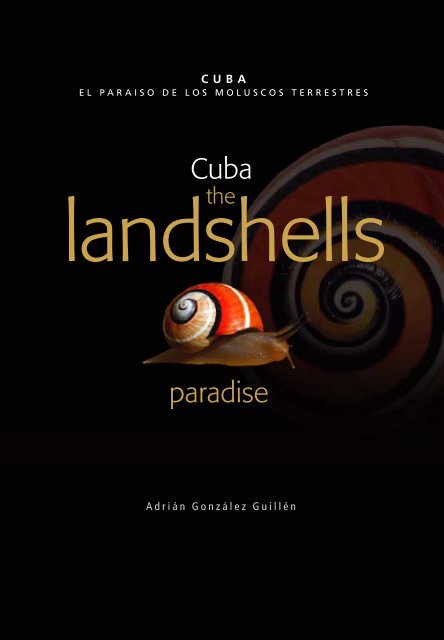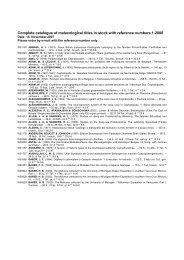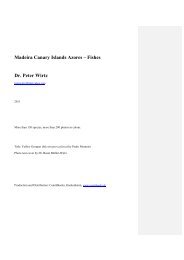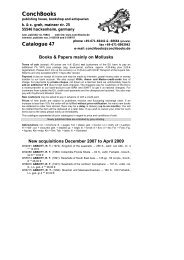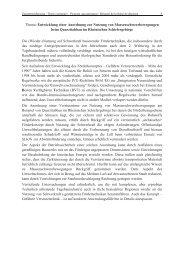Untitled - Conchbooks
Untitled - Conchbooks
Untitled - Conchbooks
Create successful ePaper yourself
Turn your PDF publications into a flip-book with our unique Google optimized e-Paper software.
One of our most endangered tree snails: Liguus fasciatus goodrichi. Trinidad, Sancti Spiritus.<br />
Uno de nuestros moluscos arborícolas más amenazados: Liguus fasciatus goodrichi. Trinidad, Sancti Spiritus.<br />
6<br />
© Adrián González Guillén<br />
Prologue<br />
Introduction<br />
Chapter 1<br />
Conquering the Land.<br />
Chapter 2<br />
The Diversity of Cuban Molluscs.<br />
Chapter 3<br />
An approach to the<br />
ground-dweller cuban landsnails.<br />
Chapter 4<br />
Rock-dwelling Molluscs.<br />
Chapter 5<br />
Arboreal Molluscs and Natural Forests.<br />
Chapter 6<br />
Polymita, Multi-coloured Fragility.<br />
Chapter 7<br />
S.O.S Liguus.<br />
Chapter 8<br />
Predators and Survival Strategies.<br />
Chapter 9<br />
Threatened or Endangered.<br />
Plates<br />
Bibliographic sources used for Tables<br />
General Reference for readers.<br />
38-79<br />
80-89<br />
90-127<br />
128-151<br />
152-183<br />
184-221<br />
222-231<br />
232-249<br />
252-301<br />
304<br />
305<br />
Introducción<br />
Capítulo 1<br />
La conquista de la tierra.<br />
Capítulo 2<br />
Malacodiversidad cubana.<br />
Capítulo 3<br />
Un acercamiento a los moluscos<br />
terrícolas cubanos.<br />
Capítulo 4<br />
Moluscos petrícolas.<br />
Capítulo 5<br />
Moluscos arborícolas y bosques tropicales.<br />
Capítulo 6<br />
Polymita: fragilidad multicolor.<br />
Capítulo 7.<br />
Liguus S.O.S.<br />
Capítulo 8<br />
Depredadores y estrategias de supervivencia.<br />
Capítulo 9<br />
Amenazas y extinciones.<br />
Láminas<br />
Fuentes bibliográficas usadas en las Tablas.<br />
Referencia General para lectores.
� Polymita sulphurosa flammulata. Guajaca 3, Sagua de Tánamo, Holguín.<br />
Over the past 150 years there has been<br />
great interest in the fascinating land<br />
molluscs of Cuba. Malacologists of Cuba:<br />
Felipe Poey, Carlos de la Torre, Carlos<br />
Guillermo Aguayo, Miguel L. Jaume and<br />
others have extensively written on the<br />
subject as have American malacologists<br />
including Paul Bartsch and Wiliam J.<br />
Clench.<br />
The one thing lacking in all of these<br />
publications has been the inclusion of<br />
color images depicting these molluscs in<br />
their native habitat. Fortunately, this is<br />
now remedied in this new work “Cuba, the<br />
Landshells Paradise”.<br />
With this new volume and its array of<br />
beautiful images and useful information<br />
there should be a renewed interested<br />
in the molluscs of the lands of Cuba and<br />
it is to be hoped that new generations,<br />
not only of malacologists, but of the lay<br />
person as well will learn to appreciate their<br />
beauty in color and form and their great<br />
diversity of habitat, the pressing need to<br />
help preserve the latter from destruction<br />
and degradation...so that those Cubans in<br />
future years will still be able to marvel at<br />
these creatures and still be able to observe<br />
them in their natural settings.<br />
TOM RICE<br />
Editor,“Of Sea and Shore” magazine.<br />
Los fascinantes moluscos terrestres de Cuba<br />
han despertado gran interés durante los últimos<br />
150 años.<br />
Malacólogos de Cuba: Felipe Poey, Carlos de<br />
la Torre, Carlos Guillermo Aguayo, Miguel L.<br />
Jaume y otros, han escrito extensamente sobre<br />
el tema, al igual que malacólogos norteamericanos<br />
como Paul Bartsch y Wiliam J. Clench.<br />
La ausencia de imágenes en color, mostrando<br />
a los moluscos en su hábitat natural,<br />
era el gran problema de estas publicaciones.<br />
Afortunadamente, ahora se ha remediado con<br />
este trabajo reciente “Cuba, el paraíso de los<br />
moluscos terrestres´´.<br />
Con este nuevo volúmen, y su rico contenido<br />
en información útil y bellas imágenes, se verá<br />
renovado el interés en los moluscos de los<br />
paisajes de Cuba. Es de esperar que las nuevas<br />
generaciones, no sólo de malacólogos, aprendan<br />
a apreciar sus formas y colores, además<br />
de reconocer la necesidad imperiosa de ayudar<br />
a protegerlos, impidiendo la destrucción y<br />
degradación de la gran diversidad de hábitats<br />
que son fundamentales para su supervivencia...<br />
para aquellos cubanos que en años futuros<br />
podrán maravillarse con esas criaturas y observarlas<br />
en su medio natural.<br />
TOM RICE<br />
Editor de la revista “Of Sea and Shore”.<br />
8 9
� Macroceramus sp. Baitiquirí, Guantánamo.<br />
� Urocoptidae. Los Negros, Jiguaní, Santiago de Cuba.<br />
� Caracolus najazensis. Sierra de Najasa, Camagüey.<br />
72 73
Comparing the Nipe-Sagua-Baracoa massif with<br />
the Sierra de los Órganos mountain range, the<br />
former outnumbers the latter in families (26), a<br />
fact that is based on geomorphologic and flora<br />
characteristics.<br />
Both areas have equal number of genera (64);<br />
however, the Sierra de los Órganos exhibits a<br />
larger number of species (230).<br />
Most of the land mollusks in Cuba are located<br />
in the mountains, given that distribution patterns<br />
are based on a combination of factors such as<br />
shade, humidity, shady or sunny slopes, particular<br />
topography, soils and different plant formations,<br />
which lead to the isolation of the populations.<br />
Large geographic areas with a high diversity<br />
of microhabitats, and rugged ground under the<br />
effects of shade and rain provided multiple conditions<br />
in the mountainous areas of Cuba for the<br />
emergence of ecological niches where, inexorably,<br />
events of speciation occurred which favored<br />
the vast diversity of our malacological fauna.<br />
© Adrián González Guillén<br />
� Glyptemoda torrei freirei.<br />
�<br />
Los Negros, Jiguaní, Santiago de Cuba.<br />
En Cuba, la mayoría de las especies de moluscos<br />
terrestres se localizan en las montañas, ya que los<br />
modelos de distribución se deben a la combinación<br />
de factores como sombra, humedad, pendientes<br />
expuestas o sombreadas, suelos y diferentes formaciones<br />
vegetales que provocan el aislamiento de las<br />
poblaciones.<br />
Áreas con una amplia extensión geográfica, alta<br />
diversidad de microhábitats, topografía accidentada<br />
bajo el efecto especial de las condiciones de sombra<br />
y lluvia ofrecieron en las zonas montañosas de Cuba<br />
múltiples condiciones para el surgimiento de nichos<br />
ecológicos donde, inexorablemente, ocurrieron eventos<br />
de especiación que propiciaron la vasta diversidad<br />
de nuestra fauna malacológica.<br />
Liguus fasciatus torrei. South coastal zone of Guanahacabibes.<br />
Liguus fasciatus torrei. Zona costera sur de Guanahacabibes.<br />
�<br />
Veronicella Tenax.<br />
Hoyo de los Helechos, San Carlos, Pinar del Río.<br />
Polymita venusta. Las Calabazas, Holguín.<br />
78 79<br />
© Adrián González Guillén
� � Alcadia spectabilis. El Cojo, Pico Turquino, Granma.<br />
Arboreal Molluscs<br />
and Natural<br />
Forests<br />
The biological megadiversity of ecosystems<br />
peaks in coral reefs, rain forests and<br />
islands. Ecosystems act through the functional<br />
interrelation of their species. If we destroy any<br />
of them, the whole system could change. In<br />
terrestrial ecosystems, thousands of kilometers of<br />
forests are felled in the whole world with profit-<br />
making purposes, consumed by a degrading<br />
force that is translated into cultivating, obtaining<br />
wood, fuel, and stockbreeding areas, which<br />
destroys the natural habitat of thousands of<br />
species.<br />
Despite a series of efforts made, natural woods<br />
in Cuba cover today only 14 % of its territory,<br />
and this alarming percentage is even impoverished,<br />
although there are well-preserved areas.<br />
These forests hold the biggest part of over 6,500<br />
species of endemic superior plants described for<br />
the island. Our principal forest areas are located<br />
in mountain ecosystems, which boast the greatest<br />
richness and biological diversity in Cuba.<br />
Many forests remain in plain areas, though. Over<br />
70% of the endemic flora of the country is located<br />
in these mountain ecosystems.<br />
Chapter 5<br />
Capítulo 5<br />
Moluscos arborícolas<br />
y bosques naturales<br />
El pico de la megadiversidad biológica puede<br />
encontrarse en los arrecifes coralinos, en los bosques<br />
lluviosos tropicales y en las islas. El ecosistema actúa<br />
a través de la interrelación funcional de sus especies;<br />
si destruimos algunas de ellas, todo el sistema podría<br />
cambiar. En los ecosistemas terrestres, miles de<br />
kilómetros de bosques son talados cada año, con<br />
fines netamente lucrativos, consumidos por una<br />
fuerza degradante que se traduce, esencialmente,<br />
en la obtención de madera, combustible, áreas para<br />
cultivo y ganadería, lo que altera y destruye el hábitat<br />
natural de miles de especies.<br />
En Cuba, a pesar de los esfuerzos realizados hasta<br />
el presente, los bosques naturales cubren actualmente<br />
sólo el 14% de todo el territorio, y este<br />
alarmantemente bajo porcentaje está disminuyendo.<br />
Afortunadamente, existen áreas muy bien conservadas<br />
que contienen la mayor parte de los bosques,<br />
con los endémicos de las más de 6500 especies de<br />
plantas superiores descritas para la isla. Nuestras<br />
principales áreas boscosas están localizadas en los<br />
ecosistemas de montaña, que son los que cuentan<br />
con una mayor riqueza y diversidad biológica en<br />
Cuba. En estos ecosistemas de montaña se localiza<br />
más del 70% de la flora endémica del país.<br />
La pérdida de más del 80% de la cobertura de<br />
bosques naturales de la isla, junto a la fragmentación<br />
128 129<br />
© Adrián González Guillén<br />
�<br />
Sugar cane fields,<br />
Santiago de Cuba.<br />
Campos de caña de azúcar,<br />
Santiago de Cuba.
� � Polymita picta iolimbata. El Corojo (Montecristo) , Ovando, Maisí, Guantánamo. � � Polymita picta iolimbata. El Beril, Ovando, Maisí, Guantánamo.<br />
172 173<br />
© Adrián González Guillén<br />
© Adrián González Guillén
Liguus fasciatus torrei. La Grifa, Guanahacabibes, Pinar del Río.<br />
© Adrián González Guillén<br />
Liguus fasciatus torrei. Guanahacabibes, Pinar del Río.<br />
190 191<br />
© Adrián González Guillén
1<br />
Plate<br />
Lámina<br />
Orthalicidae<br />
Liguus<br />
1. L. flammellus organensis. Clench, 1934.<br />
2-3. L. f. bermudezi. Clench, 1934.<br />
4-6. L. f. flammellus. Clench, 1934.<br />
7. L. f. cervus. Clench, 1934.<br />
8. L. f. carbonarius. Clench, 1934.<br />
9-16. L. vittatus. Swainson, 1822.<br />
17-21. L. fasciatus viridis. Clench, 1934.<br />
252 253
19<br />
Plate<br />
Lámina<br />
Helmintoglyptidae<br />
Polymita<br />
1-29. P. muscarum. Lea, 1834.<br />
30-52. P. picta picta. Born, 1780.<br />
288


